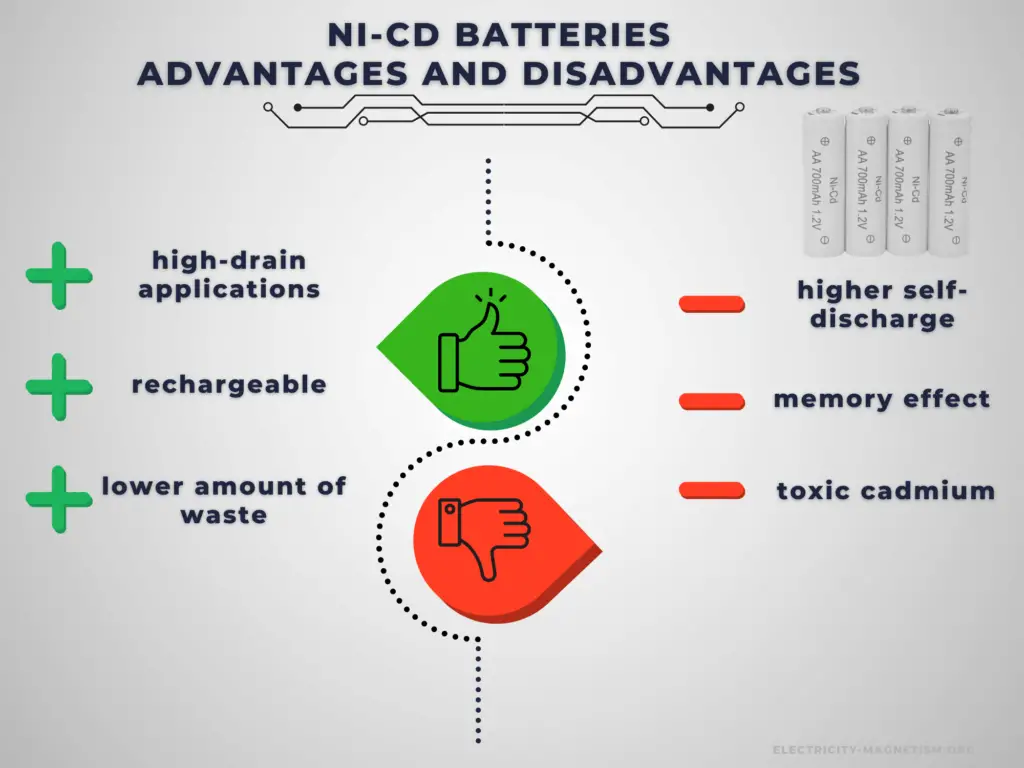Nickel Metal Hydride Battery
A nickel metal hydride battery, NiMH, is a rechargeable battery with a positive electrode made of nickel hydroxide and a negative electrode made of a metal hydride (a hydrogen-absorbing alloy). The NiMH battery was commercially introduced in 1989 and was mainly used as a power source in portable personal computers. Since then, the NiMH battery system has become very popular in electric hybrid vehicles and makes up 10% of the total market for rechargeable batteries. Compared to the NiCd battery, the NiMH provides 40 percent higher specific energy resulting in about two times higher capacity. NiMH batteries are also less affected by voltage depression, but the main advantage is the absence of toxic cadmium. The memory effect of NiMH batteries is much less than nickel-cadmium batteries.
Compared to alkaline batteries, the internal resistance of NiMH batteries is much lower. Because of this, they have the advantage that a higher voltage can be maintained under high load.
With high specific energy (up to 100Wh/kg) and energy density (double of lead-acid and 40% more than nickel-cadmium), high cycle life, low cost, recyclability (cadmium is hazardous), and other qualities made it the most used battery and still nowadays is one of the most used. Its applications are much diverse: battery cells AA or AAA, cameras, old mobile phones, electric razors, medical instruments and equipment, and high-power static applications. Compared to the lead-acid battery, the drawback is that it is more expensive than lead acid per kWh.
NiMH batteries are (re)charged by applying electric current, which reverses the chemical reactions that occur during discharge/use. Devices to supply the appropriate current are called chargers. The electronics in charging systems and control circuits for NiMHs are simple and inexpensive, and the battery is considered safe. The NiMH battery also has high self-discharge and can lose up to 20 % of its charge during the first 24 hours and thereafter 10 % per month.
Like NiCd batteries, they have a nominal voltage of 1.2V per cell with a typical end-of-discharge voltage of 1V.
The total voltage of the redox reaction is E0 = 0.49V – ( – 0.83V) = 1.32V.
Nevertheless, they are widely used as a replacement for alkaline batteries, which have 1.5V nominal voltage per cell, in many applications and are commonly found in standard battery designs. In some applications, however, the lower nominal voltage can be a disadvantage. For example, unregulated lights that are designed for 1.5V operation tend to shine less brightly.
Advantages and Disadvantages of Nickel Metal Hydride Batteries

Advantages:
The main advantage of rechargeable cells is that they may be recharged after discharge. Therefore, rechargeable batteries are more environmentally friendly than primary batteries. Not only can they be used repeatedly, but they generate less waste over the long term. This is particularly true in the case of power-intensive devices, which consume batteries at an increased rate. Another very important advantage is a high C-rate. Rechargeable cells have better power output capabilities compared to primary cells and are used for high-power applications.
There are several specific advantages to NiMH batteries.
- delivers high current output
- rapid recharge capability
- less expensive than lithium-based battery systems
Disadvantages:
Battery price is one of the challenging factors in choosing the right rechargeable battery for your device or applications. It greatly affects the decision of the buyer. Rechargeable batteries have higher initial costs than their primary counterparts. Another important disadvantage is their self-discharge. In low-drain applications, the service life is more important, and the self-discharge characteristics of a rechargeable battery mean that they are less suitable for use as the primary energy source.
There are several specific disadvantages to NiMH batteries.
- not suitable for shallow cycling
- lower specific energy and specific power than lithium-based battery systems

